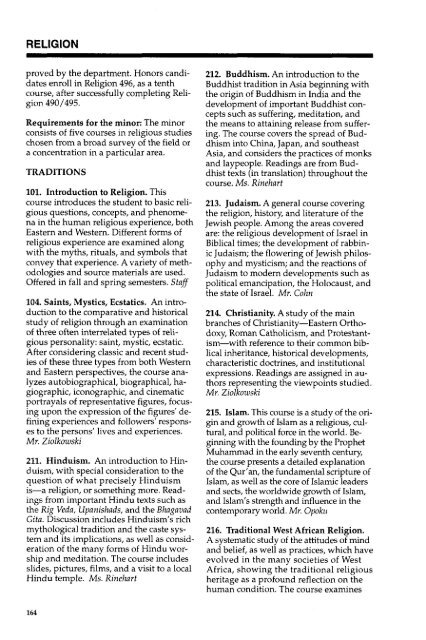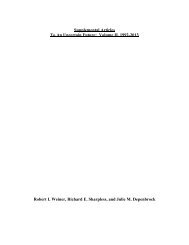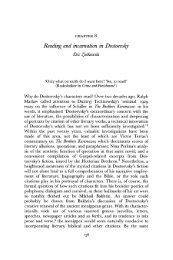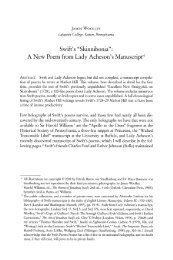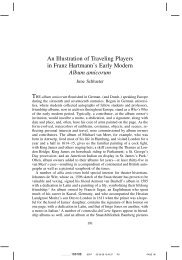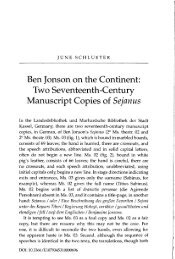courses of instruction - Lafayette College
courses of instruction - Lafayette College
courses of instruction - Lafayette College
You also want an ePaper? Increase the reach of your titles
YUMPU automatically turns print PDFs into web optimized ePapers that Google loves.
RELIGION<br />
proved by the department. Honors candi<br />
dates enroll in Religion 496, as a tenth<br />
course, after successfully completing Reli<br />
gion 490/495.<br />
Requirements for the minor: The minor<br />
consists <strong>of</strong> five <strong>courses</strong> in religious studies<br />
chosen from a broad survey <strong>of</strong> the field or<br />
a concentration in a particular area.<br />
TRADITIONS<br />
101. Introduction to Religion. This<br />
course introduces the student to basic reli<br />
gious questions, concepts, and phenome<br />
na in the human religious experience, both<br />
Eastern and Western. Different forms <strong>of</strong><br />
religious experience are examined along<br />
with the myths, rituals, and symbols that<br />
convey that experience. A variety <strong>of</strong> meth<br />
odologies and source materials are used.<br />
Offered in fall and spring semesters. Staff<br />
104. Saints, Mystics, Ecstatics. An intro<br />
duction to the comparative and historical<br />
study <strong>of</strong> religion through an examination<br />
<strong>of</strong> three <strong>of</strong>ten interrelated types <strong>of</strong> reli<br />
gious personality: saint, mystic, ecstatic.<br />
After considering classic and recent stud<br />
ies <strong>of</strong> these three types from both Western<br />
and Eastern perspectives, the course ana<br />
lyzes autobiographical, biographical, ha-<br />
giographic, iconographic, and cinematic<br />
portrayals <strong>of</strong> representative figures, focus<br />
ing upon the expression <strong>of</strong> the figures' de<br />
fining experiences and followers' respons<br />
es to the persons' lives and experiences.<br />
Mr. Ziolkowski<br />
211. Hinduism. An introduction to Hin<br />
duism, with special consideration to the<br />
question <strong>of</strong> what precisely Hinduism<br />
is a religion, or something more. Read<br />
ings from important Hindu texts such as<br />
the Rig Veda, Upanishads, and the Bhagavad<br />
Gita. Discussion includes Hinduism's rich<br />
mythological tradition and the caste sys<br />
tem and its implications, as well as consid<br />
eration <strong>of</strong> the many forms <strong>of</strong> Hindu wor<br />
ship and meditation. The course includes<br />
slides, pictures, films, and a visit to a local<br />
Hindu temple. Ms. Rinehart<br />
164<br />
212. Buddhism. An introduction to the<br />
Buddhist tradition in Asia beginning with<br />
the origin <strong>of</strong> Buddhism in India and the<br />
development <strong>of</strong> important Buddhist con<br />
cepts such as suffering, meditation, and<br />
the means to attaining release from suffer<br />
ing. The course covers the spread <strong>of</strong> Bud<br />
dhism into China, Japan, and southeast<br />
Asia, and considers the practices <strong>of</strong> monks<br />
and laypeople. Readings are from Bud<br />
dhist texts (in translation) throughout the<br />
course. Ms. Rinehart<br />
213. Judaism. A general course covering<br />
the religion, history, and literature <strong>of</strong> the<br />
Jewish people. Among the areas covered<br />
are: the religious development <strong>of</strong> Israel in<br />
Biblical times; the development <strong>of</strong> rabbin<br />
ic Judaism; the flowering <strong>of</strong> Jewish philos<br />
ophy and mysticism; and the reactions <strong>of</strong><br />
Judaism to modern developments such as<br />
political emancipation, the Holocaust, and<br />
the state <strong>of</strong> Israel. Mr. Cohn<br />
214. Christianity. A study <strong>of</strong> the main<br />
branches <strong>of</strong> Christianity Eastern Ortho<br />
doxy, Roman Catholicism, and Protestant<br />
ism with reference to their common bib<br />
lical inheritance, historical developments,<br />
characteristic doctrines, and institutional<br />
expressions. Readings are assigned in au<br />
thors representing the viewpoints studied.<br />
Mr. Ziolkowski<br />
215. Islam. This course is a study <strong>of</strong> the ori<br />
gin and growth <strong>of</strong> Islam as a religious, cul<br />
tural, and political force in the world. Be<br />
ginning with the founding by the Prophet<br />
Muhammad in the early seventh century,<br />
the course presents a detailed explanation<br />
<strong>of</strong> the Qur'an, the fundamental scripture <strong>of</strong><br />
Islam, as well as the core <strong>of</strong> Islamic leaders<br />
and sects, the worldwide growth <strong>of</strong> Islam,<br />
and Islam's strength and influence in the<br />
contemporary world. Mr. Opoku<br />
216. Traditional West African Religion.<br />
A systematic study <strong>of</strong> the attitudes <strong>of</strong> mind<br />
and belief, as well as practices, which have<br />
evolved in the many societies <strong>of</strong> West<br />
Africa, showing the traditional religious<br />
heritage as a pr<strong>of</strong>ound reflection on the<br />
human condition. The course examines


